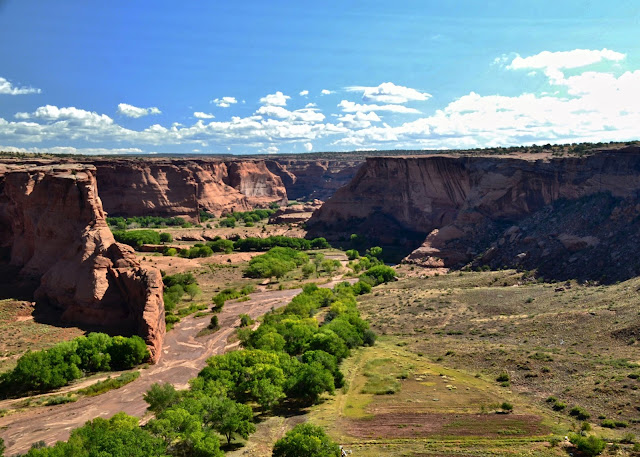A Hole in the Ground in the West
The Navajo call it Tseyi, meaning canyon. It's pronounced tsch-eh-yee. The Spanish did the best they could, with "ch" for the first sound, the double ll that gives them "ye", and y at the end for "ee". That spelled chelly, an approximation that comes out cha-ye-yee.
The Spanish spelling remains Chelly, and the official name is Canyon de Chelly on maps and at the park service. In English we mangle the pronunciation into Canyon d'Shay. The Navajo ignore it all and spell it Tseyi on their road signs on the reservation. It's confusing.
 |
| The camera fails to capture the immense scope and size. |
It's another landmark in the west where ancient civilizations built complex apartments in the rock cliffs. It's huge -- three branching canyons that each meander 35 miles or more in different directions, enclosed by rock walls that rise 1,000 feet.
 |
| There were hundreds of cliff homes in the canyons until A.D. 1350 when the population left, migrating to the Rio Grande along with the people from Chaco and Mesa Verde. |
National parks in the west tend to be large holes in the ground. Fascinating, awe-inspiring, historically rich, but all are giant cracks in the earth: the Grand Canyon, Bandelier, Chaco Canyon, Mesa Verde, Canyon de Chelly. The ancients sought out these immense holes in the earth for the water at the bottom and the defensive safety of rock walls.
 |
| Peach orchards were the pride of the Navajo and fruit trees are still grown throughout the canyon. |
What distinguishes Chelly, though, is that here the bottom land is wide and fertile and there are apple and peach orchards, corn fields, sheep and cattle grazing, and working farms all up and down the canyon. From 1,000 feet up at the rim, looking down, it looks like tiny little Swiss villages tucked along the river wash.
 |
| From 1,000 feet up, standing at the rim, looking down at bottomland orchards and farms. |
What also distinguishes Chelly is that the Navajo still farm there. Sixty families still work the land and it is off limits to tourists unless a Navajo guide takes you down into the canyon on a guided tour.
We went with a Native guide in a jeep that could barely handle the sandy washouts and deep ruts of the canyon bottom. But he navigated expertly, and was a great source of information about the specifics of the petroglyphs, pictographs, canyon botany, the history of conflict when the Spanish and Americans came (as always), and even who filmed what Hollywood western in which place.
 |
| It's hard to capture the scale of that looming 800 foot rock wall, streaked with cobalt and magnesium, with ancient dwellings tucked in it and below it. |
Our guide's nephew appeared out of one canyon draw, riding his horse bareback from a campsite nearby, looking the epitome of a young wild Indian boy. We chatted for a bit. Our guide's mother was visiting relatives under some cottonwoods at one stop and he paused to visit, being a good son.
At another spot in the canyon floor, we passed a farm where he told us his auntie lived. She had kept 32 sheep, but this summer a mountain lion got a few. She dispatched the lion, which was still in the corral eating, with an army issue M1. A week later a bobcat got more and the M1 came out again to effective use. Navajo women are warriors, our guide told us.
He grew up in the canyon from age 2 to 16. He had to hike out every day to go to school. At 16 he dropped out, left the reservation and became a wildfire jumper in Florida and other places. But he came back. Despite his lack of education he was well informed and articulate and passionate about what makes Tseyi so special. We were impressed.
 |
| Compounds were built into crevasses hundreds of feet up from the canyon floor. |
He was particularly informed about the archeology findings and latest theories about the ancient civilizations that lived here. We asked if he had wanted to study archeology at any point, he was so interested. No, he said, emphatically. There are no Navajo archaeologists. We don't dig up our dead.
The whole jeep ride was fascinating.
 |
| Do you see two owls side by side? Do you see E.T.? And a turtle? Mother Nature is a sculptor on a very large scale. |
Here's some news -- our road trip misadventure hex has broken! We had no adverse events, no weather extremes, no climate anomalies, no flat tires, no scary adventures. We are no longer being tested on our trips. Do you think the west has finally accepted that two former Easterners are here to stay?
Comments